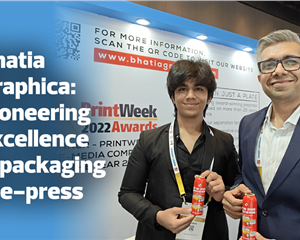The evolving legacy of Archies
In its heyday, Archies was synonymous with greeting cards. As the internet stole the thunder from the cards business, Archies has always managed to remain relevant in the stationery business. Jagdish Moolchandani, executive director, Archies, shares the secrets of the company’s success with Rahul Kumar
24 Mar 2020 | By PrintWeek Team
If you grew up in the 1990s, in the country in the cusp of economic liberalisation, you could not have missed Archies, its New Year greeting cards, and theme cards for every possible occasion, its notebooks and gift items. Archies made us feel modern and hip. Archies made us feel global. At the time, it was hard to believe that Archies was a 100% Indian company, which started with publishing booklets of English songs in 1979.
It has been a roller-coaster since for the New Delhi-based company, which, over the years, has displayed an unusual streak for reinventing itself with the changing market trends. So when the heydays of greeting cards were winding down, the company decided to focus on specialised stationery items — notebooks, customised calendars, gift items — adding new products and retiring others depending on the market demand all the while retailing them though its franchise stores bearing the Archies name.
Today, as the debate over the use of plastic heats up, the company is already on its way to capture the next big market, paper bags as alternatives to the plastic carry bags.
When we visited the company shopfloor in Manesar near Gurgaon a couple of months ago, a new paper bag-making machine was under installation, while piles of bags for brands such as Adidas was ready for shipping.
Archies went public in 1995 and remains a fast-growing gift and gallery company in India. Yet, when we met Jagdish Moolchandani, executive director at Archies, he was only too happy to walk down the memory lane with us.
For the love of music It started with the Moolchandani brothers’ — Anil and Jagdish — love for Hollywood movies, and pop songs — The Beatles, Boney M, Bee Gees, what have you. Still in college, Moolchandani confesses, they did not understand the lyrics, but loved the music. But they did want to understand the lyrics. And they realised, there must be others like them who loved the music of their favourite bands and wanted to understand the lyrics.
So the brothers found someone who ‘knew’ English and who could transcribe the lyrics. With the transcriptions in hand, they found a letterpress printer and started producing song booklets for all popular bands of the 1970s.
“We started selling the booklets in front of the cinema hall in Daryaganj,” Moolchandani says. Soon, the booklets were available in bookstores as well. It was a novelty, and the idea was an instant hit, so much so that one of their early titles sold 50,000 copies in one year.
As the demand for lyric booklets grew, the brothers decided to cash on it and soon started printing posters of the musicians as well as popular Hollywood actors. The year was 1979-80, and Bruce Lee was the heartthrob of every Indian youth. His 1973 film Enter the Dragon was a massive hit and the brothers started selling life-size posters of Bruce Lee, not just in New Delhi, but across India. Moolchandani especially mentions the North East, a geography which was already exposed to the Western media, and it pushed the business in a big way. “In the first year alone, in 1979, we did a business of Rs 60,000,” he says. “We started it as a hobby and we were happy to have earned such an amount doing what we loved to do.”
Business of a hobby
A year or so later, it was time to take his hobby seriously. With the business of lyric booklets and posters (the brothers had now started printing generic and popular posters featuring landscape scenery, babies and such), the brothers decided to move out of Daryaganj and focus on a new idea, greeting cards. This was the beginning of Archies.
“The greeting cards had a boom time between 1985 and 2000. At the time, there were more than hundred greetings cards manufacturers in Mumbai and around 50 in New Delhi, but we developed such novelty with our product that we were immediately accepted in the market,” Moolchandani says.
The company tied up with Walt Disney and other overseas companies to use their designs and found service providers in Okhla and Naraina to print the cards.
Everything worked like a charm — the innovation, the design, printing quality, the price — and the company’s market went up.
But when you are offering innovative products in the market, you also need a dedicated space to sell them. Thus, the first Archies Gallery shopfront came up in Daryaganj in 1981-82. Daryaganj was an obvious choice as the Moolchandanis grew up in the area. The front of the property was a retail shop. At the back, there was an office and the print production facility.
“Initially, we went to the market on our own, and later appointed dealers. Gradually, we started distributing franchises of Archies Gallery. At the same time, we ventured into stationery, autograph books, slam books, exercise books, notebooks, photo albums and created a concept that a shop can be opened with these products,” Moolchandani explains.
By 1987-88, as the franchises of Archies Gallery started to crop up all across India, the company realised that its printing demands are enough to establish its own print production facility and went for it. Today, Archies Gallery has around 140 franchises and 200 company-run shops in India. Today, all Archies products are manufactured at its Manesar facility and shipped to all over India.
The company acquired the 15,000-sqm plot in Manesar in 2000 and shifted print production facility to the location in 2009.
Today, the entire print production is under one roof.
Archies employs 175 people at its print production facility and around 200 people sit in its head office in Naraina Industrial Area. And around 600 people work in its 200 company-run shops across India.
The business of cards
“We started printing in Naraina with a fourcolour printing press. Later, we added three more four-colour presses, plus hot-foil stamping, die-cutting machines. We printed 80% of our production in-house,” Moolchandani says.
During its peak, Archies produced two to three-lakh greeting cards per day. “Cards for Diwali, Raksha Bandhan, New Year and Christmas were the bestsellers,” he explains.
“In 1984-85, we started St Valentine’s Day greeting cards and it was an instant hit.” The company has its own creative teams for artwork and content. It also has tie-ups with a few USA companies to licence their designs, including Walt Disney.
Greeting cards ruled the roost until 2000.
With the advent of the internet and the novelty of eCards, the youth, which were the main customers of greeting cards, started losing interest in printed cards. As smartphones became a norm a couple of years later, the popularity of greeting cards went down drastically.
Moolchandani says today the company’s greeting cards business is just 25% as compared to the business it had when it was at its peak. “Today, we sell greetings cards worth Rs 20-crore per annum. Earlier, it used to be Rs 55-crore per annum. We print few thousands cards of each design,” he says.

Today, Archies Gallery has around 140 franchises and 200 company-run shops in India
Moving forward
Once the greeting cards business saw a dip, the company focused on gift items, and increased its stationery portfolio, such as photo albums, slam books and notebooks.
“We also manufacture gift wrapping paper ranging from Rs 10 to Rs 100. The wrapping papers are in demand during the festival season, like Diwali and Christmas. We sell around 50-lakh sheets of paper in one season,” he says.
There is no dearth of ideas for product development at Archies. In stationery alone, the company manufactures 50 different varieties of products, including organisers of different shapes and sizes and year-less daily calendar featuring inspirational quotes. “The stationery products are in high and regular demand compared to greeting cards and gift items,” he adds.
However, the most saleable product in Archies’s stationery inventory is the highend notebook. It is made with special paper, design and binding.
Now, as plastic is going to be banned or already being banned in India, Moolchandani explains that the company has entered into paper bags manufacturing. “We have installed two semi-automatic paper bag manufacturing machines. We are pushing the boundaries in the paper bag segment,” he says.
About the new venture, which was started around three years ago, Moolchandani says, while the market is full of opportunities, it is also very competitive. “We manufacture for big brands, corporates and export to overseas markets,” he adds.
The Archies legacy So, what’s the key to the success of the Archies brand? The answer is simple — constant innovation. “We always renovate our products and shops, and manufacture products according to the market demand, especially demanded by youth. At the same time, we try to gauge what the market would like,” Moolchandani says.
The company has its own creative team with its own studio where they work on content, artwork, concepts and so on. “The first step to a new product development is to identify the concept,” he says. “Sometimes we generate the concept and sometimes we take inspirations from overseas markets. Then the concept is shared with the research and development team and they create multiple dummy samples. The selected sample is converted into the final shape, following which we go for development of the product and select processes and materials.”
The process is followed every year for all Archies product categories. “We start working for the next season around nine months earlier. We also take a stock of the previous year’s inventory to see what kind of products worked and what did not,” he adds.
You may follow the trend, work out the price point and other aspects of a product, but you can never be certain what kind of product will work and what will not. Moolchandani says it’s up to the customer. And for him, customer feedback is essential. Every weekend, he visits four to five shops and speaks to the staff.
His last word on print? Moolchandani says print will always be there, but how print is being used will continue to change and evolve.












 See All
See All